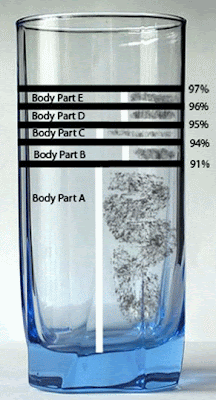by Phil Billman –
In last month’s issue (http://www.bradfordbarthel.com/BLOG/V5N1/Five-5.htm, I described how the DEU’s erroneous approach to apportionment inappropriately expands employer PD exposure. In this article I use the a “Glass of PD Method” to illustrate this point.
Assuming an empty glass represents 0% PD and a full glass 100% PD, let’s review an example from our last article. Applicant suffered accepted injuries to five different body parts, A through E, as outlined in the table below. The PD for each body part received at least 50% apportionment. In another words, the employer was found liable for no more than half of the PD associated with each of the body part. Without apportionment, the total PD was 97%.
Can you guess how much PD the employer must pay? Let’s review. The total PD without apportionment stands at 97%. The employer is, based on the apportionment determinations, responsible for no more than 50% of the PD for any one body part. Thus, logic would suggest the employer is liable for something less than half of 100% PD.
“WRONG”, says the DEU.
If you leave it to the DEU, PD is 62% after apportionment! How can injuries giving rise to less than 100% with at least 50% apportioned away result in employer liability for greater than 50% PD?
There is a logical, reasonable and practical alternative (aka The “B&B alternative”):
|
|
|
|
|
|
|
We have already “poured” the PD into the glass in the order combined, largest to smallest. (Note: illustration is not to scale.)
The black lines represent the amount of PD contributed by each body part.
The white vertical lines represent the apportionment, with the shaded (right) side being the industrial portion (that is, industrially-caused PD)
Clearly less than one-half of the glass is shaded. So where does the DEU go wrong?
Simple—once the PD goes in the glass, we cannot just pour it out. After all, it is Permanent Disability.
The DEU’s calculations remove the non-industrial portion of the disability as if it wasn’t there. However, if you ask the injured worker—it’s still there!
Now a quick lesson on combining using the same glass.
Body Part A had 91% PD and PD is PD; you can’t make it anything else. It doesn’t transform into something other than PD simply because the employer is not responsible for some of it. Body Part B, by itself, represents 34% PD, but now there is only 9% space left inf our “Glass of PD” (100% – 91% = 9%). So 34% of the remaining 9% is now affected, or 3% additional PD (91 c 34 = 94). The process continues for the remaining body parts.
Using the DEU method, Body Part A is magically improved to 46% PD (91% times 50% industrial). And Body Part B is improved to 11% PD (34% times 33% industrial). But, the 11% is now applied to the remaining 54% (100% – 46%) resulting in Body Part B being worth 6% PD (46 c 11 = 52, a 6% increase in PD)! Without considering any other body parts, the employer is paying for more than half of the total 94% disability (91 c 34 = 94% PD before apportionment).
OUCH!
Viewing this website does not form an attorney/client relationship between you and Bradford & Barthel, LLP or any of its attorneys. This website is for informational purposes only and does not contain legal advice. Please do not act or refrain from acting based on anything you read on this site. This document is not a substitute for legal advice and may not address every factual scenario. If you have a legal question, we encourage you to contact your favorite Bradford & Barthel, LLP attorney to discuss the legal issues applicable to your unique case. No website is entirely secure, so please be cautious with information provided through the contact form or email. Do not assume confidentiality exists in anything you send through this website or email, until an attorney/client relationship is formed.


